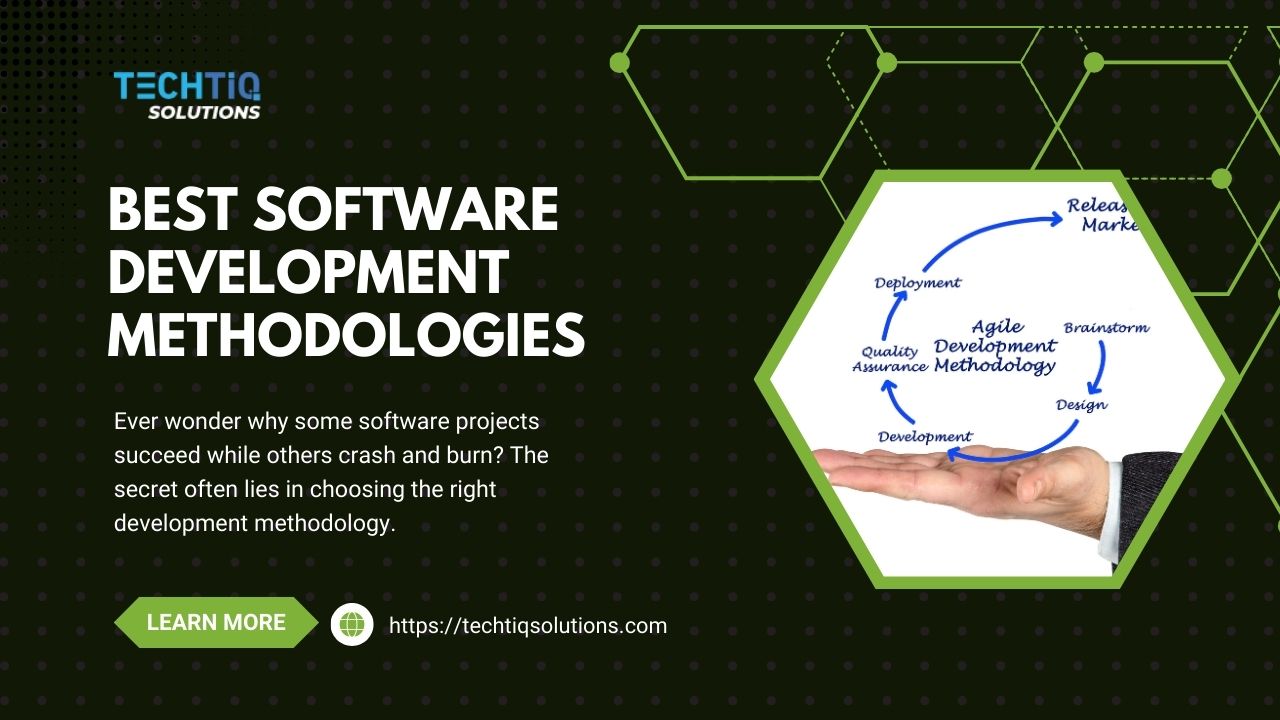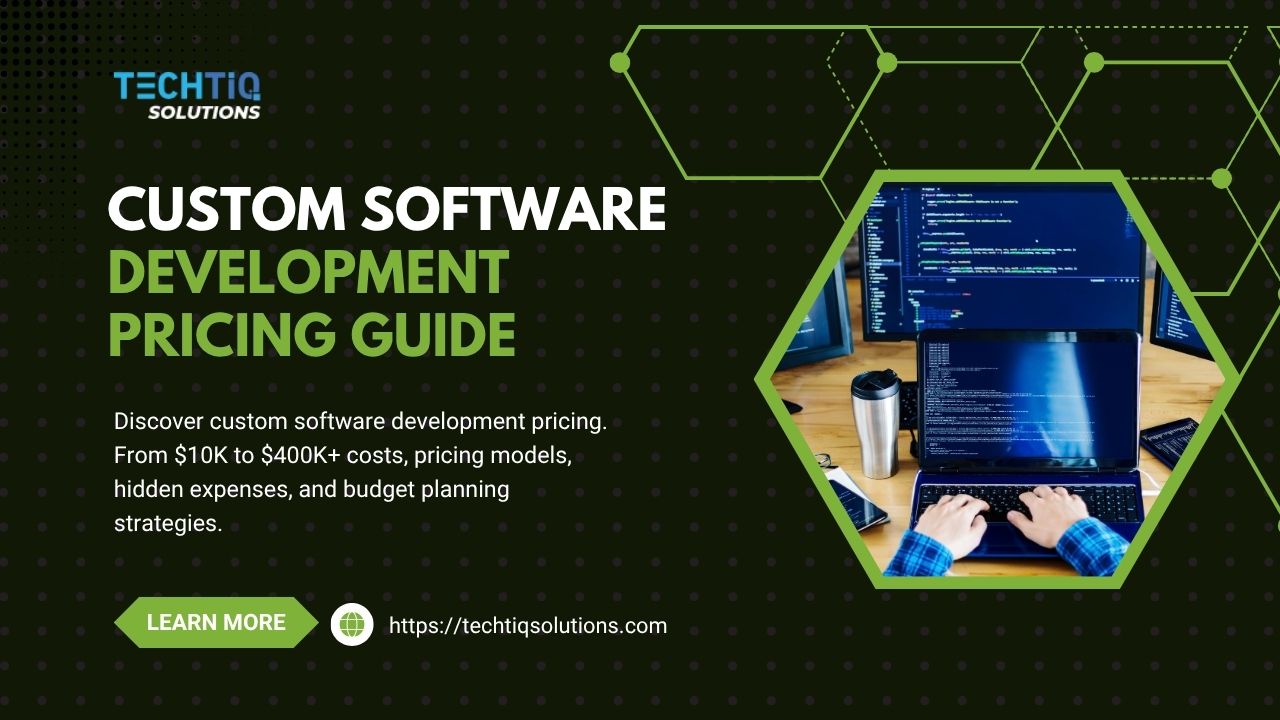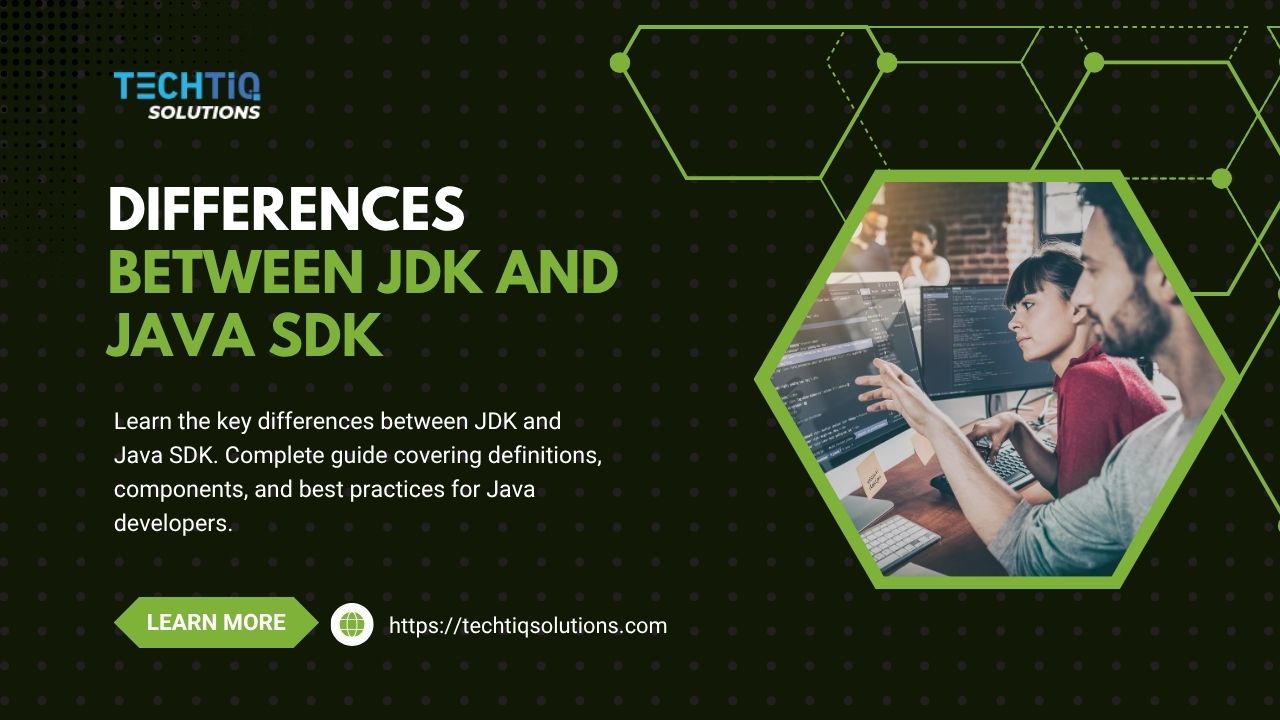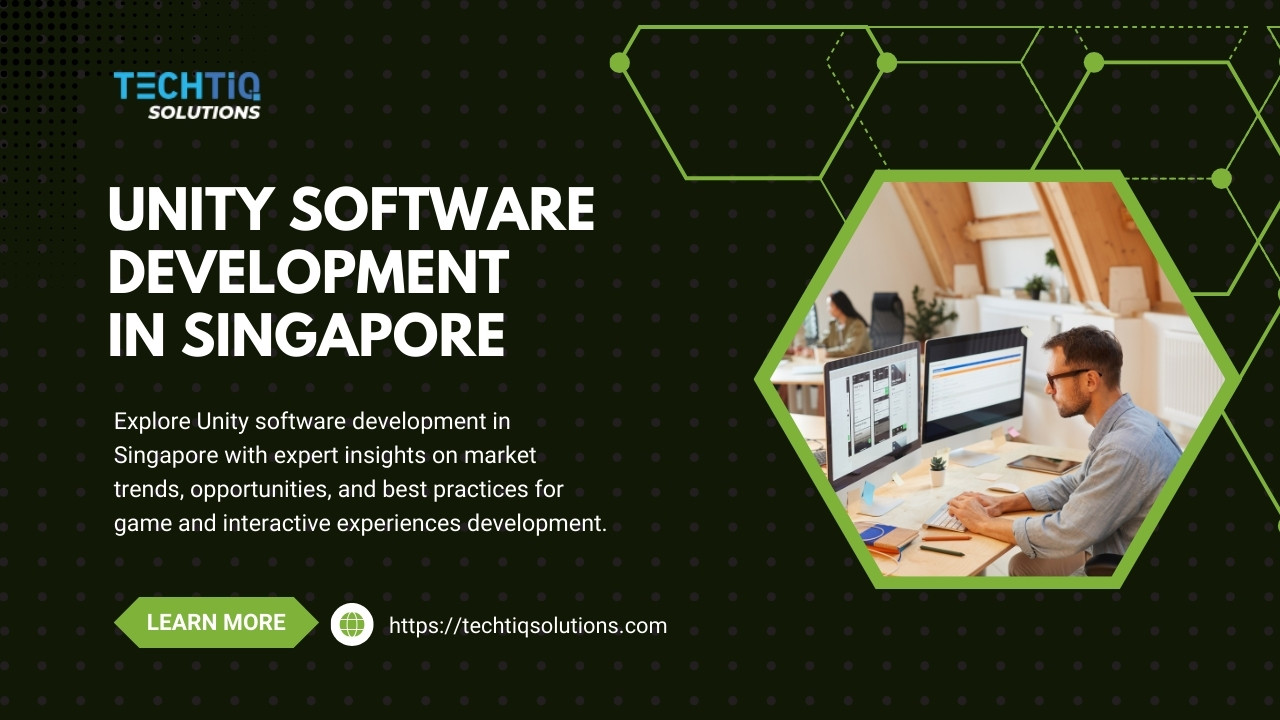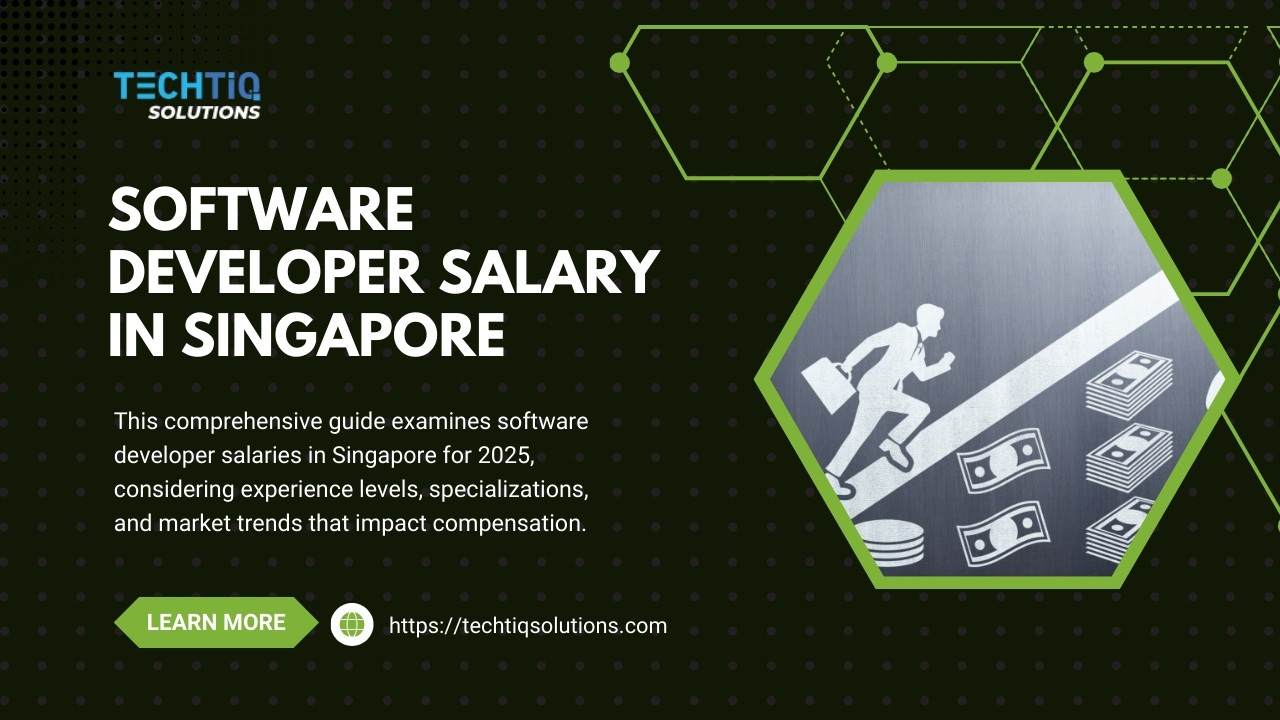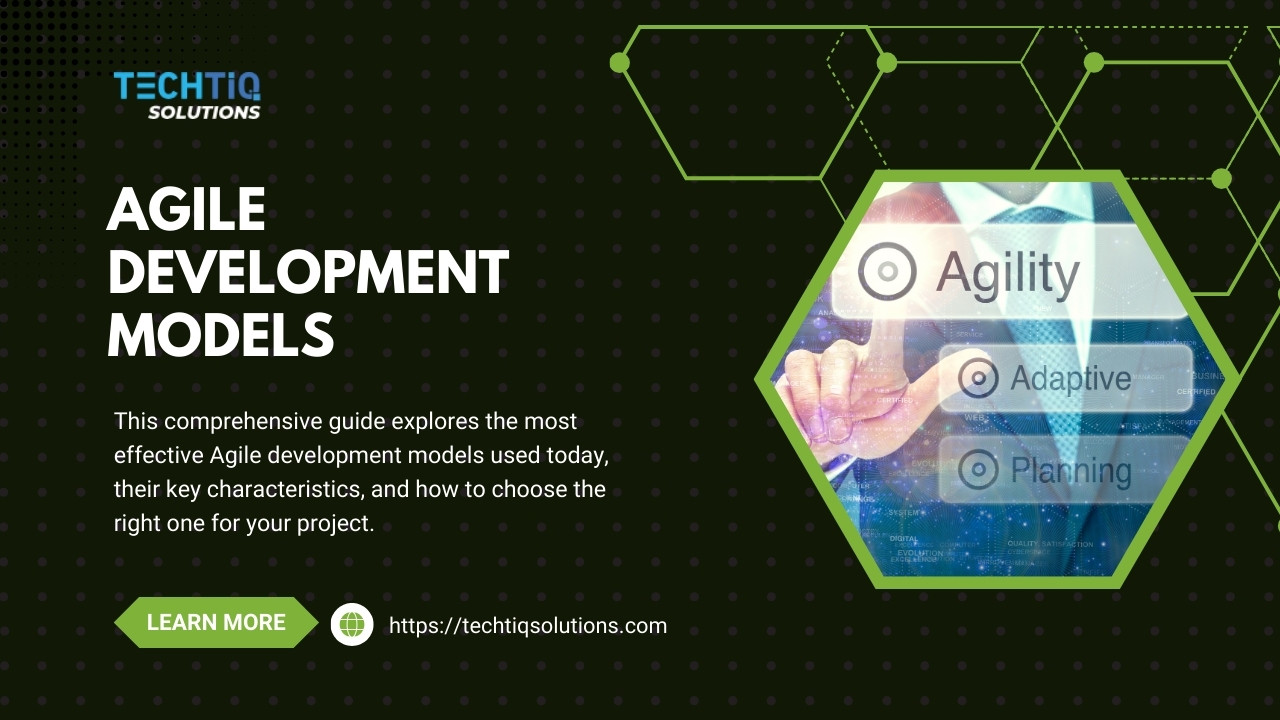Ever wonder why some software projects succeed while others crash and burn? The secret often lies in choosing the right development methodology. With countless approaches available these days, finding the perfect fit for your project can feel overwhelming. But don’t worry – we’ve done the heavy lifting for you.
Key Takeaways
-
Different software development methodologies serve different business needs – from rapid development to high stability requirements
-
Agile methodologies like Scrum and Kanban offer flexibility and faster time-to-market with 64-70% success rates compared to 49-58% for Waterfall
-
Traditional approaches like Waterfall provide more structure for projects with fixed requirements but have higher failure rates (up to 29%)
-
Hybrid methodologies combine elements of multiple approaches for customized solutions, with growing popularity in regulated industries
What Are Software Development Methodologies?
Software development methodologies are structured approaches that guide how teams plan, build, test, and deploy software products. Think of them as roadmaps that help developers navigate the complex journey from concept to completed product.
These frameworks provide guidelines for organizing tasks, managing resources, and establishing workflows that keep projects on track. The right methodology aligns with your business goals, team structure, and project requirements, serving as the foundation for successful software development.
According to research from Netguru, software development methodologies “provide a framework for planning and controlling the creation of an information system”. By implementing a well-defined methodology, organizations can significantly improve project outcomes and delivery reliability.
Let’s explore the 15 best software development methodologies that can transform your next project.
1. Agile Methodology
Agile has revolutionized software development by embracing change rather than fighting it. This methodology breaks projects into small, manageable iterations called sprints, typically lasting 1-4 weeks.
Key Principles of Agile
-
Individuals and interactions over processes and tools
-
Working software over comprehensive documentation
-
Customer collaboration over contract negotiation
-
Responding to change over following a plan
Agile thrives in environments where requirements evolve throughout the development process. It encourages constant feedback, allowing teams to adjust their approach as they learn more about user needs.
Benefits of Agile
-
Faster delivery of usable software
-
Greater flexibility to accommodate changes
-
Improved stakeholder engagement
-
Reduced risk through early detection of issues
-
Enhanced team collaboration and morale
According to the 15th State of Agile Report, an impressive 94% of organizations now practice agile in some form. This widespread adoption speaks to its effectiveness, with studies showing that agile projects are 28% more successful than traditional projects (PwC Global Project Management Report).
When to Use Agile
Agile works best when your project requirements aren’t fully defined upfront or are likely to change. It’s ideal for innovative products where user feedback shapes future development. For custom software development projects where client needs may evolve, Agile provides the flexibility to adapt while maintaining progress toward business goals.
2. Scrum Methodology
Scrum is the most popular Agile framework, used by 66% of Agile teams according to recent industry surveys. It provides a structured yet flexible approach to managing complex projects.
How Scrum Works
Scrum revolves around short development cycles called sprints, with three key roles:
-
Product Owner: Represents stakeholders and maintains the product backlog
-
Scrum Master: Facilitates the process and removes obstacles
-
Development Team: Self-organizing group that delivers work
The framework includes regular ceremonies:
-
Sprint Planning
-
Daily Scrum (standup meetings)
-
Sprint Review
-
Sprint Retrospective
Why Teams Choose Scrum
Scrum creates a transparent environment where everyone knows what’s happening. The framework’s clear roles and regular meetings keep projects moving forward while maintaining the flexibility to adapt to changing requirements.
Studies show that teams adopting Scrum experience 49% increased customer satisfaction and enhanced communication across stakeholders (Simform, State of Agile Adoption).
TechTIQ Case Study: Mobile Team Manager
TechTIQ Solutions successfully applied Scrum methodology while developing the Mobile Team Manager project, a cloud-based software solution for field service management.
According to the case study, TechTIQ “used Jenkins to auto-build and deliver new software updates” and implemented “automation test scripts on Selenium” – practices that align perfectly with Scrum’s emphasis on continuous delivery and quality assurance.
The project required managing complex features like interactive scheduling screens, e-signature integration, and electronic forms. By using Scrum’s iterative approach, TechTIQ delivered a solution that helped clients “solve paperwork and reduce company time and cost.”
3. Kanban Methodology
Kanban, meaning “visual card” in Japanese, originated in Toyota’s manufacturing processes before being adapted for software development. It focuses on visualizing work, limiting work in progress, and maximizing flow.
Core Components of Kanban
-
Kanban Board: Visual representation of work items, typically divided into columns representing workflow stages
-
Work in Progress (WIP) Limits: Constraints on how many items can be in each stage at once
-
Continuous Flow: Emphasis on completing work items before starting new ones
Benefits of Kanban
-
Identifies bottlenecks quickly
-
Minimizes context switching
-
Improves predictability with consistent delivery
-
Enables continuous improvement without disrupting workflow
-
Provides flexibility without fixed iterations
Research indicates about 34% of teams now use Kanban for managing their development process (Statista, 2022). Its visual workflow management makes it particularly effective for support and maintenance teams who need to balance varying priorities.
When to Choose Kanban
Kanban works particularly well for support and maintenance teams dealing with unpredictable tasks. It’s also excellent for teams transitioning from traditional methods to Agile, as it can be implemented without significant process changes.
According to industry research, Kanban is best suited for “projects with a complicated domain, where you will find complex problems, good practices, and expert profiles” (Alaimo Labs, 2024).
4. Lean Software Development
Adapted from Toyota’s lean manufacturing principles, Lean Software Development focuses on eliminating waste and delivering maximum value with minimum resources.
The Seven Principles of Lean
-
Eliminate Waste: Remove anything that doesn’t add customer value
-
Build Quality In: Prevent defects rather than fixing them later
-
Create Knowledge: Document learning and share it throughout the organization
-
Defer Commitment: Make decisions at the last responsible moment
-
Deliver Fast: Reduce cycle time to deliver value quickly
-
Respect People: Empower team members and respect their expertise
-
Optimize the Whole: Consider the entire value stream, not just individual parts
Why Choose Lean
Lean software development helps teams focus on what truly matters. By eliminating unnecessary work and optimizing the development process, organizations can reduce costs while improving quality and delivery speed.
Industry data shows that Lean is used by approximately 29% of development teams (Statista, 2022) and often complements other Agile practices to enhance efficiency and value delivery.
5. Waterfall Methodology
Waterfall is the traditional, sequential approach to software development. Each phase must be completed before the next begins, creating a cascading flow like a waterfall.
Waterfall Phases
-
Requirements: Gathering and documenting all project requirements
-
Design: Creating the software architecture and design specifications
-
Implementation: Writing the actual code
-
Verification: Testing the software against requirements
-
Maintenance: Fixing issues and making improvements after release
Advantages of Waterfall
-
Clear milestones and deliverables
-
Thorough documentation at each stage
-
Predictable timeline and budget
-
Well-defined requirements before development begins
-
Easier for new team members to understand
When Waterfall Works Best
Waterfall shines in projects with well-defined, stable requirements that are unlikely to change. It’s often used in regulated industries where thorough documentation is mandatory, or for projects with fixed constraints around time, budget, and scope.
While Waterfall usage has declined to about 26% of teams (Statista, 2022), it remains valuable for specific scenarios. According to research, Waterfall projects have success rates of 49-58%, compared to 64-70% for Agile projects (Ambysoft IT Project Success Survey).
6. DevOps Methodology
DevOps bridges the gap between development and operations, fostering collaboration and automation throughout the software lifecycle.
Key DevOps Practices
-
Continuous Integration (CI): Merging code changes frequently
-
Continuous Delivery (CD): Automating the release process
-
Infrastructure as Code: Managing infrastructure through code
-
Monitoring and Logging: Maintaining visibility into application performance
-
Microservices: Breaking applications into smaller, independent services
Benefits of DevOps
-
Faster time to market
-
Improved collaboration between teams
-
Higher quality through automated testing
-
More stable operating environments
-
Faster recovery from failures
DevOps has seen rapid growth in recent years, with adoption increasing from 36% in 2021 to 47% in 2022 (DevOps Statistics, K&C). Organizations implementing DevOps report significantly faster delivery times, with one study indicating 50% faster time-to-market (DeltaMatrix Study).
TechTIQ Case Study: BAIBAI Cryptocurrency Exchange
TechTIQ Solutions implemented DevOps methodologies when developing BAIBAI, a cryptocurrency exchange website. The case study reveals that TechTIQ used various DevOps practices including:
-
“Load balancing” for high availability
-
“Stress test by Jmeter” for performance testing
-
“Redis cache cluster” for scalability
-
“Database cluster” for reliability
-
“CI/CD pipeline” for continuous integration and delivery
This DevOps approach helped the platform handle their ambitious targets of “1,000,000 visitors per second” and “10 trades completed per second” while ensuring all pages rendered in under 5 seconds.
7. Extreme Programming (XP)
Extreme Programming takes the best practices of software development to “extreme” levels, focusing on technical excellence and customer satisfaction.
Core Practices of XP
-
Pair Programming: Two developers work together at one workstation
-
Test-Driven Development (TDD): Writing tests before code
-
Continuous Integration: Integrating and testing code frequently
-
Refactoring: Continuously improving code quality
-
Small Releases: Delivering value in small increments
-
Simple Design: Creating the simplest solution that works
Why Consider XP
XP excels at producing high-quality code with fewer defects. Its emphasis on testing and pair programming creates a built-in review process that catches issues early. The methodology also responds well to changing requirements, making it suitable for projects where client needs evolve rapidly.
Though less widely adopted than some other methodologies (about 7% usage according to industry surveys), XP offers significant quality benefits when implemented properly.
8. Feature-Driven Development (FDD)
Feature-Driven Development organizes work around features that deliver tangible value to users. It combines the best aspects of Agile with a focus on delivering regular, concrete results.
The FDD Process
-
Develop Overall Model: Create a high-level overview of the system
-
Build Feature List: Break down requirements into feature sets
-
Plan by Feature: Assign ownership and schedule development
-
Design by Feature: Create detailed designs for each feature
-
Build by Feature: Implement and test individual features
Advantages of FDD
-
Clear focus on delivering customer value
-
Regular, tangible progress
-
Scalable to large teams and projects
-
Strong emphasis on quality through inspections and reviews
-
Good traceability from requirements to implementation
FDD is particularly well-suited for larger projects that can be broken down into smaller, feature-centric iterations. It provides more structure than some Agile methods while maintaining flexibility, making it suitable for organizations transitioning from traditional approaches.
9. Dynamic Systems Development Method (DSDM)
DSDM is an Agile framework that focuses on the full project lifecycle, making it especially suitable for business-driven projects.
DSDM Principles
-
Focus on Business Need: Deliver what brings real business value
-
Deliver on Time: Use timeboxing to ensure timely delivery
-
Collaborate: Involve stakeholders continuously
-
Never Compromise Quality: Set quality standards upfront
-
Build Incrementally: Deliver solutions in increments
-
Develop Iteratively: Be ready to reverse changes
-
Communicate Clearly: Ensure clear, direct communication
-
Demonstrate Control: Monitor progress against business goals
When to Use DSDM
DSDM works well in corporate environments where business value is paramount. It provides more structure than some Agile methods while maintaining flexibility, making it suitable for organizations transitioning from traditional approaches.
For enterprise software development projects with complex business requirements, DSDM offers a comprehensive framework that balances agility with governance, ensuring business objectives remain the central focus.
10. Spiral Methodology
The Spiral model combines elements of waterfall with iterative development, adding risk analysis at each phase. This makes it particularly valuable for large, high-risk projects.
How the Spiral Model Works
Each “spiral” passes through four quadrants:
-
Planning: Defining objectives and constraints
-
Risk Analysis: Identifying risks and finding solutions
-
Engineering: Developing and testing
-
Evaluation: Assessing results and planning the next iteration
Benefits of the Spiral Approach
-
Early identification and mitigation of risks
-
Accommodates changing requirements
-
Allows for user feedback throughout development
-
Works well for large, complex systems
-
Provides clear documentation at each stage
According to academic research, the Spiral model is “predominantly utilized for larger, more complex projects” and its “focus on risk management is particularly advantageous in environments subject to high levels of uncertainty and evolving technology” (Yeng et al., 2020).
11. Rapid Application Development (RAD)
RAD prioritizes rapid prototyping and quick feedback over extensive planning. This approach aims to deliver working software quickly while remaining responsive to change.
RAD Phases
-
Requirements Planning: Defining high-level requirements
-
User Design: Creating prototypes through user feedback
-
Construction: Building the system while refining prototypes
-
Cutover: Transitioning from development to production
When RAD Makes Sense
RAD works best when time-to-market is critical, requirements can be modularized, and you have skilled developers familiar with the business domain. It’s particularly effective for user interface development where visual feedback is valuable.
Academic research suggests RAD “has proven to be effective in environments where requirements are expected to evolve rapidly, balancing the need for speed with the necessity of quality control” (Firdose & Rao, 2018).
12. Crystal Methodology
Crystal is a family of Agile methodologies that emphasizes people over processes. It recognizes that each project is unique and provides a lightweight framework that can be tailored to specific needs.
Crystal Variants
-
Crystal Clear: For small teams (up to 8 people)
-
Crystal Yellow: For medium teams (10-20 people)
-
Crystal Orange: For larger teams (20-50 people)
-
Crystal Red: For very large teams (50-100 people)
Core Properties of Crystal
-
Frequent Delivery: Delivering working software regularly
-
Reflective Improvement: Regular team retrospectives
-
Close Communication: Co-location or effective remote communication
-
Personal Safety: Freedom to speak without fear of reprisal
-
Focus: Uninterrupted time to work
-
Easy Access to Expert Users: Regular contact with stakeholders
Why Teams Choose Crystal
Crystal appeals to organizations that value team autonomy and adaptability. Its lightweight approach focuses on what’s essential, allowing teams to find their own path to success rather than prescribing rigid processes.
13. Prototype Methodology
The Prototype methodology focuses on developing initial versions of a system to validate concepts and gather feedback before full implementation.
Types of Prototyping
-
Throwaway Prototyping: Creating models solely for feedback, then discarding them
-
Evolutionary Prototyping: Refining the initial prototype until it becomes the final system
-
Incremental Prototyping: Building multiple prototypes that eventually integrate into a complete system
-
Extreme Prototyping: Using a three-phase approach focused on presentation, services, and data
Benefits of Prototyping
-
Reduces risk by validating concepts early
-
Improves user involvement and satisfaction
-
Clarifies requirements through tangible examples
-
Detects issues before full implementation
-
Particularly valuable for innovative or unfamiliar solutions
TechTIQ’s Experience with Prototype Methodology
According to TechTIQ Solutions’s company information, they utilize Prototype methodology as one of their core approaches. This aligns with their focus on creating Minimum Viable Products (MVPs) and Proof of Concept (PoC) solutions to “accelerate time-to-market, gather user feedback, and efficiently test software concepts.”
14. Iterative and Incremental Development
Iterative and Incremental Development combines elements of both approaches: building the product in small chunks (increments) while refining existing functionality through repeated cycles (iterations).
How It Works
-
Initial Planning: Creating a high-level roadmap
-
Incremental Delivery: Building the product one piece at a time
-
Iteration: Refining each increment based on feedback
-
Continuous Integration: Regularly combining new increments with existing code
Advantages of Iterative and Incremental Development
-
Provides working software early and often
-
Allows for feedback throughout the development cycle
-
Reduces risk through continuous validation
-
Accommodates changing requirements without major disruption
-
Works well for both small and large projects
This hybrid approach offers flexibility while maintaining structure, making it suitable for projects that require regular delivery while managing evolving requirements.
15. Scaled Agile Framework (SAFe)
SAFe applies Agile principles to enterprise-level development, providing a structured approach for large organizations with multiple teams working on related products.
SAFe Levels
-
Team Level: Standard Agile teams using Scrum or Kanban
-
Program Level: Coordinating multiple teams as an Agile Release Train
-
Large Solution Level: Coordinating multiple release trains
-
Portfolio Level: Aligning development with business strategy
When to Consider SAFe
SAFe is designed for large enterprises with 50+ developers working on complex systems. It helps coordinate work across teams while maintaining Agile principles. If your organization struggles with Agile at scale, SAFe provides a comprehensive framework to address these challenges.
Industry research indicates that SAFe has seen dramatic growth in enterprise settings over the past five years, becoming one of the most widely adopted frameworks for scaling Agile across large organizations.
Software Development Methodologies Comparison
|
Methodology |
Best For |
Key Benefits |
Potential Challenges |
Planning Horizon |
Adoption Rate |
|
Agile |
Projects with evolving requirements |
Flexibility, faster delivery, client involvement |
Less predictable, requires active stakeholder participation |
Short-term (2-4 weeks) |
94% of organizations |
|
Scrum |
Complex projects needing structure with flexibility |
Clear roles, regular progress, adaptability |
Requires dedicated roles, daily meetings |
Sprint length (1-4 weeks) |
61% of agile teams |
|
Kanban |
Support/maintenance, workflow optimization |
Visualization, continuous flow, flexibility |
Limited timeboxing, requires team discipline |
Continuous flow |
34% of teams |
|
Lean |
Efficiency-focused projects |
Waste reduction, quality focus, speed |
Requires organizational commitment |
Varies |
29% of teams |
|
Waterfall |
Well-defined, stable requirements |
Clear structure, thorough documentation |
Inflexible to changes, late testing |
Full project timeline |
26% of teams |
|
DevOps |
Projects needing rapid deployment |
Faster releases, improved collaboration |
Cultural change required, technical complexity |
Continuous |
47% of teams (2022) |
|
XP |
Small-medium teams, quality-critical projects |
High quality code, fast feedback |
Intensive practices, requires technical expertise |
Very short (days to 1-2 weeks) |
~7% of teams |
|
FDD |
Feature-rich applications |
Feature-based progress, quality focus |
Less emphasis on project management |
2 weeks per feature |
Data limited |
|
DSDM |
Business-value driven projects |
Business focus, structured approach |
More complex than other Agile methods |
Time-boxed iterations |
Data limited |
|
Spiral |
High-risk, large projects |
Risk management, accommodates changes |
Complex, resource-intensive |
Multiple cycles |
Data limited |
|
RAD |
UI-intensive applications, tight deadlines |
Speed, user feedback integration |
Requires skilled developers, less documentation |
60-90 days typical |
Data limited |
|
Crystal |
Teams valuing autonomy, varied project sizes |
Team empowerment, adaptability |
Less prescriptive, requires team maturity |
Varies by project |
Data limited |
|
Prototype |
Innovative projects, unclear requirements |
Early validation, user feedback |
Potential for scope creep |
Variable |
Data limited |
|
Iterative |
Most software projects |
Manageable chunks, regular feedback |
Needs good planning, potential integration issues |
Multiple iterations |
Data limited |
|
SAFe |
Large enterprises, complex systems |
Coordination at scale, business alignment |
Significant overhead, complex implementation |
Multiple levels (team to portfolio) |
Growing in enterprises |
How to Choose the Right Software Development Methodology
Selecting the appropriate methodology depends on several factors:
Project Characteristics
-
Project Size: Larger projects may benefit from more structured approaches like SAFe or a hybrid method
-
Complexity: Complex projects with many unknowns might do better with iterative approaches
-
Criticality: Mission-critical systems might require more rigorous methodologies with extensive testing
-
Timeline: Tight deadlines might favor rapid development approaches like RAD or Kanban
Team Factors
-
Team Size: Larger teams often need more structure and coordination
-
Experience: Consider the team’s familiarity with different methodologies
-
Distribution: Co-located teams have different needs than distributed ones
-
Culture: Some methodologies align better with certain organizational cultures
Business Considerations
-
Budget Constraints: Some methodologies require more resources than others
-
Stakeholder Involvement: Consider how involved clients and users need to be
-
Regulatory Requirements: Some industries require extensive documentation
-
Risk Tolerance: Higher-risk projects might benefit from spiral or other risk-focused approaches
According to a Gartner survey of 1,402 technology professionals, 43% voted for Agile/Scrum as the “best” methodology for enterprise-level projects, whereas only 13% favored Waterfall. This highlights the industry’s shift toward more flexible approaches.
When choosing a methodology for custom software development projects, it’s crucial to align the approach with your specific business objectives, team capabilities, and project constraints.
Hybrid Approaches: The Future of Software Development
Many successful organizations now blend methodologies to create customized approaches that suit their specific needs. These hybrid models take the best elements from multiple methodologies, creating flexible frameworks that evolve with the organization.
For example, a team might use Scrum for development while incorporating DevOps practices for deployment and operations. Or they might follow a lightweight version of SAFe for coordination while teams use Kanban for day-to-day work management.
This hybrid approach is gaining significant traction, with industry research showing that approximately 30% of organizations now use a hybrid methodology. In finance and healthcare sectors specifically, hybrid agile-waterfall usage reaches over 50% (PMI, 2024), reflecting the need to balance flexibility with regulatory compliance.
According to TechTIQ’s company information, they leverage “Agile, Scrum, DevOps, Lean, and Prototype methodologies in software development.” This adaptable approach allows them to tailor their process to each client’s unique requirements.
TechTIQ Case Study: Smart GIS Project
TechTIQ Solutions demonstrated the power of selecting the right methodology in their Smart GIS project for a client specializing in location intelligence software. The project involved developing a comprehensive mapping solution with features like custom visualizations, insights analysis, and drawing tools.
Facing challenges including an unfamiliar business domain and complex mathematical equations, TechTIQ adopted a hybrid approach. They implemented Agile methodologies while collaborating with the UK team on solution proposals and assessment approaches.
As stated in the case study, TechTIQ used “JetBrains’ YouTrack for facilitating maintenance and enhancement strategies, planning, prioritizing features, decomposing user stories, and enabling continuous delivery.” This methodical approach resulted in successful development of the complex GIS system with optimized front-end performance capable of handling “layers containing over a million records.”
Best Practices for Implementing Software Development Methodologies
Whatever methodology you choose, these best practices will help ensure success:
Start Small
Begin with pilot projects or teams before rolling out a new methodology across the organization. This allows you to learn and adapt with lower risk.
Provide Training
Invest in proper training for all team members. Understanding the principles behind a methodology is as important as knowing the practices.
Customize Thoughtfully
Adapt methodologies to fit your specific context, but be careful not to remove elements that provide essential value or structure.
Measure Results
Establish metrics to track whether the methodology is delivering the expected benefits. Adjust your approach based on these measurements.
Continuous Improvement
No methodology implementation is perfect from the start. Build in regular retrospectives to identify improvement opportunities.
Methodologies by Industry Sector
Different industries have varying adoption patterns for software development methodologies:
Fintech & Financial Services
Banks and financial institutions have widely embraced agile, with research showing 53% of organizations in financial services use a hybrid approach combining agile and waterfall (PMI, 2024). This blended approach enables them to balance rapid development with necessary regulatory compliance.
Healthcare
The healthcare sector has traditionally been conservative in project management but is increasingly adopting agile practices. Over 50% of healthcare-related organizations now use hybrid agile methods (PMI, 2024) to ensure patient safety while improving IT delivery.
Enterprise Technology
Large enterprises often implement scaled agile frameworks (e.g., SAFe) to coordinate across hundreds of teams. The IT sector leads in hybrid agile adoption, with approximately 55% of organizations using blended approaches (PMI, 2024).
Software Companies & Startups
Tech startups typically default to pure agile methods. The technology sector accounts for the largest share of agile practitioners (about 27% of all agile users), favoring methodologies that support rapid prototyping and quick market entry.
Conclusion
The best software development methodology isn’t a one-size-fits-all solution. It’s the approach that aligns with your project requirements, team dynamics, and business goals. Many successful organizations use different methodologies for different projects or combine elements from multiple approaches to create their ideal workflow.
As your organization evolves, be prepared to reassess and adapt your methodologies. What works today might not be optimal tomorrow. The most successful teams view methodologies as tools that serve their goals, not rigid rules that limit their options.
TechTIQ Solutions has demonstrated success with various methodologies across diverse projects. Their ability to adapt approaches based on client needs showcases the importance of methodology flexibility in delivering successful software solutions.
Ready to Find Your Ideal Software Development Approach?
Choosing and implementing the right development methodology can significantly impact your project’s success. At TechTIQ Solutions, we bring over 8 years of expertise in custom software development using proven methodologies tailored to your unique business needs.
Whether you need help selecting the best approach for your next project or support implementing a new methodology, our team of experts is ready to help.
Contact TechTIQ Solutions today to discuss how we can help you achieve your software development goals through the perfect methodology for your business. Reach out to us at inquiry@techtiqsolutions.com or call (+65) 8898 2997 to get started.
